
views
- You do not need to hire a lawyer to get a divorce in Texas unless you plan to sue on specific grounds or you want to contest the division of assets (which is 50/50 in Texas).
- You can file for divorce by filling out the case information sheet, a petition for divorce, and a suit affecting the family relationship form at your local state courthouse.
- If your spouse hires an attorney, contests the petition, or refuses to sign the waivers for an uncontested divorce, you will need to hire a lawyer.
- Once the paperwork is filed, you will need to attend a divorce hearing in front of a judge but you don’t need a lawyer if it’s an uncontested divorce.
Preparing for Your Divorce

Determine if you qualify to file for divorce in Texas. Under Texas law, at least one party to the divorce must have resided in Texas for at least six months prior to the filing of the divorce. In addition, either you or your spouse must have lived in the county where you file for 90 days prior to the date of filing. Also, a divorce in Texas cannot be finalized if the wife is pregnant. If your wife is pregnant, be sure to keep this in mind.

Determine the grounds upon which you will divorce. In Texas, you can file for divorce with or without assigning fault to one party or the other. The only grounds for a no-fault divorce in Texas are "insupportability," which means that for whatever reason, the marriage is no longer viable. If you wish to file for some other reason, such as adultery, criminality, or abandonment (among others), you need to speak with an attorney. Furthermore, if you and your spouse cannot come to an agreement with respect to the division of property and child custody and support, you need to speak with an attorney. Texas is a community property state, which means that it views the property of either spouse acquired during the marriage as the property of both spouses, and the default division of that property is an even split. However, if the court finds that one spouse is at fault for the dissolution of the marriage, then it can and will assign more property to the innocent spouse. For this reason, if you plan to sue for divorce on specific grounds, you need to speak with an attorney. If you cannot afford one, go to texaslawhelp.org for help finding a Legal Aid attorney.

Determine where to file the divorce. In Texas, state District Courts have jurisdiction over divorces. District Courts are courts of general jurisdiction. That means that they have jurisdiction over all legal matters unless specifically designated otherwise. In very small counties, or judicial districts that preside over multiple small counties, there may only be one District Court. If you live in a county like this, you would file there. In districts of larger size, the District Courts are divided into subdivisions that give preference to certain areas, like family law. These are called Family District Courts. If you live in one of these Districts, then you should file with the Family District Court. To find out whether you should file with a District Court or a Family District Court, simply go look in the directory in the Texas Pro Se Divorce Handbook. Alternatively, go to courts.texaslawhelp.org and fill in the required information.
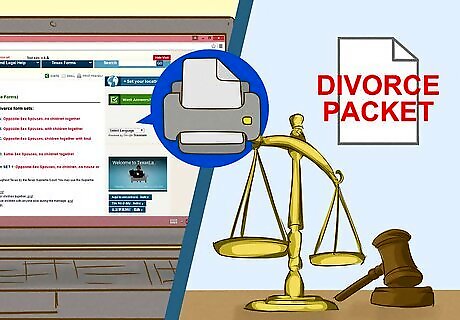
Obtain the proper forms. The forms you use will depend on whether you and your spouse have children together and if you own real property (land, houses, or other structures). The Supreme Court of Texas has approved a set of forms for filers with children, without children, and without children or property. Once you find the right category for you and your spouse, simply click on the link provided. Almost all of the forms you will need are in the packet.
Filing Your Divorce
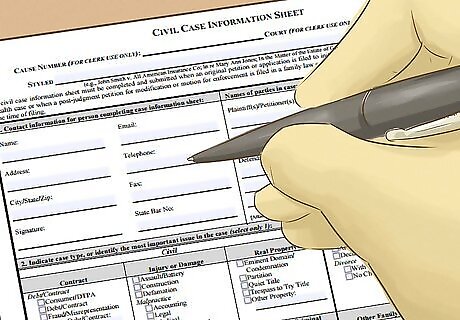
Fill out the case information sheet. Everyone in Texas who files a civil case must submit a Civil Case Information Sheet. In order to fill the form out properly, you will need to know your name, address, telephone number, and email, along with the full names of both spouses. After you have entered in that information, simply check the box in the "Family Law" section that says "divorce."
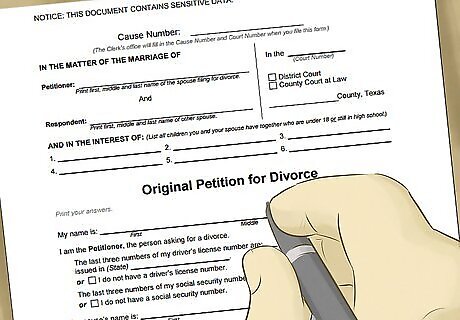
Complete the Original Petition for Divorce. The contents of the Petition are going to differ drastically depending on whether or not you and your spouse have children. The Petition for couples without children is four pages. The petition for couples with children is more than twice as long. You may leave the cause or cause number blank, the Court Clerk will fill this in when you file the documents with the Court. The addendum for custodial arrangements is extremely detailed, going so far as to specify when the weekend begins, what happens on three day weekends, and who shall have custody of the child on any and all major and minor holidays. It might be best for you each to come up with some idea of how you would like to make arrangements separately, and then come to a compromise agreement afterwards. If you have trouble coming to an agreement, consider a mediator.You can browse a national directory of mediators by going to www.mediate.com and looking at the listing for your state.
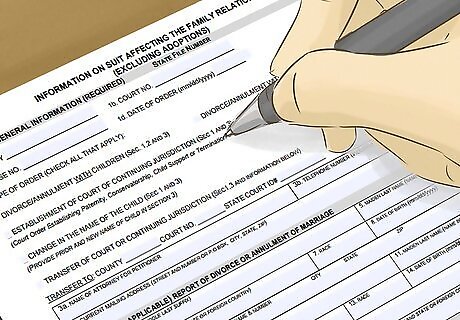
Complete the Information on Suit Affecting the Family Relationship form. You can find the form on the texaslawhelp.org website under their section on filing for divorce.
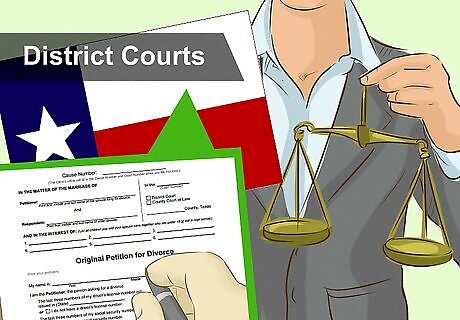
File Original Petition for Divorce. File the form with the Clerk's Office in the District Court that has jurisdiction. Your divorce does not actually begin until you file this form. Expect to pay filing fees with the county where you file. The exact amount of the fees will vary by locality, but you should expect to pay at least $200 in fees. If you qualify as indigent (poor), the filing fees will be greatly reduced or waived altogether. You can make an affirmation of indigency by filling out a form and filing it with the clerk of court.

Provide your spouse with a copy or the Petition. Your spouse must receive a copy of the petition. If your spouse agrees to waive service of process, you can just send the Petition by mail or drop it off in person. If you are unsure, then pay a process server to perform an in-person service.

Have your spouse complete the Waiver of Service form or Answer. Your spouse needs to complete a Waiver of Service or an Answer. For most people pursuing an uncontested divorce, a Waiver of Service will do. If you expect them to waive service, then just send the form along with the Petition. If your spouse signs a Waiver of Service, you are not required to provide him or her with a copy of the divorce petition, or any other filings, and he or she will not be required to attend any hearings. This is generally used only when divorcing parties are in complete agreement on all issues and will not ask for any hearings. You may file the Waiver yourself. If your spouse wishes to receive copies of your filings and attend any hearings, he or she may file an answer to your divorce petition instead of a Waiver of Service. This is generally not used in an uncontested divorce, but your situation may differ. Your spouse must file the Answer.

Along with your spouse, complete the Final Decree of Divorce. Once the Answer or the Waiver have been completed, you and your spouse should complete the final decree of divorce. In it you will confirm the division of property, child support, and custody arrangements. Calculate Child Support correctly. To determine what child support should be, use the child support calculator provided by the Travis County Court.

Have an attorney look over your forms. Anyone considering a divorce should get an attorney to at least look over the final versions of the forms. A mistake on one of these forms could lead to years of problems. Provide clear and complete information. Type or print all information in blue or black ink. Be sure to answer each questions completely and fill in every blank that applies to your situation.

File the divorce forms. Call the Clerk’s Office at the proper court and ask how many copies of each form you will need and what the filing fee will be. Make the appropriate number of copies and take to the Clerk’s office along with the filing fee, which should be in cash, as the Courts do not accept personal checks or debit cards.

Provide your spouse with notice of the divorce filing. If your spouse did not waive service of process but is still not contesting any points of the divorce, hire a process serves or another disinterested third party to serve your spouse with any remaining paperwork. However, if your divorce is uncontested because your spouse is missing, try service by publication. If you are not able to find your spouse, you may wish to serve him or her by publication. This means publishing notice of the divorce filing in a newspaper of general circulation in the last city or town where he or she was known to reside. To serve a party by publication in Texas, you must obtain the permission of the Court. In order to do this, you will need to file an affidavit with the Court stating that you are unable to find your spouse, after making an honest effort to do so.
Finalizing the Divorce

Attend your hearing. Whether the divorce is contested or uncontested, the filing party must appear at a hearing. If you and your spouse are in agreement on all issues, you may appear without your spouse at an uncontested docket hearing, which will take approximately ten minutes. You should bring all of your Court filings to the hearing.

Wait. Texas has a mandatory 60 day waiting period for divorces. The waiting period begins when you file the Petition.

Attend any required pre-divorce classes. During the 60 day waiting period and before you attend the court hearing to get your divorce decree signed, you must complete any parenting classes that are required if you have a child with your spouse. Make sure you do not blow these off as it may delay your divorce and cause the judge to impose other requirements. During these parenting classes, you will learn about the responsibilities and hardships of co-parenting after a divorce. For example, part of the course may teach you about how to handle problems that arise while parenting without your spouse around (i.e., how to be a good single parent).
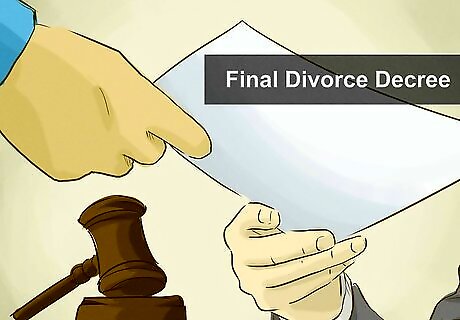
File your Final Divorce Decree and remaining forms. The Court will not prepare your Divorce Decree for you. It is up to you to prepare this document, according to the orders of the Court, and file it for the Judge to sign. The Judge will not sign the Decree until it has been 61 days from the date of filing of the Petition for Divorce. If you have children, you will need to file the Information on Suit Affecting the Family Relationship form. If support is ordered, you will also need to file the Income Withholding for Support Order, which can be found with the packet of forms for uncontested divorces with children. You will most likely need to fill this out with your employer, as there are certain pieces of information on the form not usually known to employees.

















Comments
0 comment